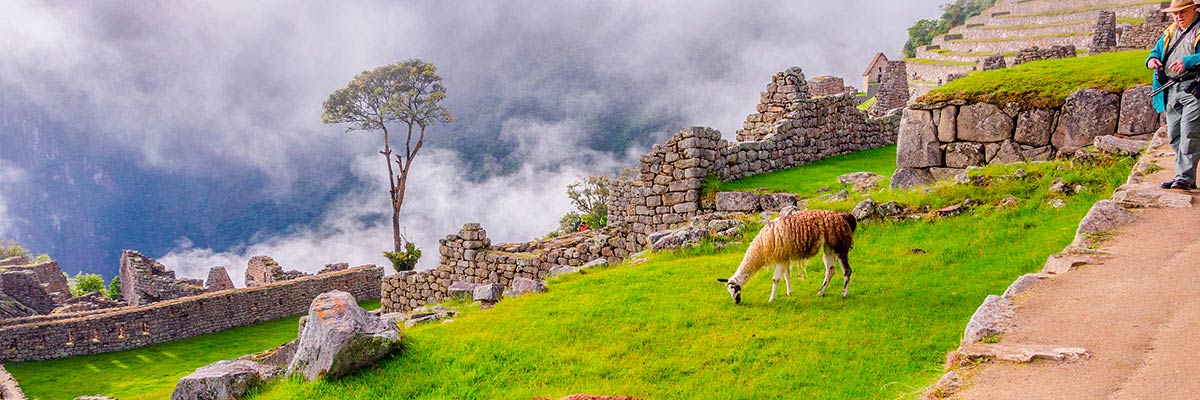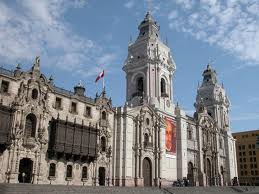
The Historic center of Lima and his Churches go across the Historical Center of Lima is always about their churches, each one of them is a small world, you can see how is that the first population of Perú was distributed, according of their social, cultural and economic status: There was religious orders who care for the poorest, like the Franciscans and Dominics, other orders who care for education, like the Jesuits and Mercedarios, and orders like the Augustinians who teach and evangelize to the local natives of the Tahuantinsuyo.
The Dominics order
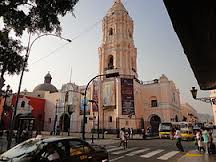
The first order to came here was the Dominics, joining to the Spanish conquers very early, one of the most important Dominics was Fray Vicente de Valverde, who was the first to get closer to Atahualpa Inca, giving him the Bible and starts what is known as the Inca capture, event that changes everything on this territory.
The Dominics was who found the first University in all América, including North América, La Universidad Nacional Mayor de San Marcos, in 1551.
The Dominic Church is made by the neoclassic style; it has a bell tower that has a Rococo style, designed by one of the Viceroy, Manual Amat y junient, in 1766, at the top of the tower there is an angel called the famous angel, with a horn or trumpet.
Inside of the Church there are many paintings that shows how was that the natives was educated and learn about the life of Christ and his sacrifice for all of us.
The order is famous for gather two of the most important religious people of all: San Martín de Porres and Santa Rosa de Lima. The first was an afro-peruvian, his father was Spanish and his mother was a free slave. From early time, Martín was dedicated to the religious way of life, his humility was one of his attributes, dedicating to the care of the people who were sick, washing their wounds and giving those homemade medicines.
This Saint was miraculous, one of their most amazing miracles that were attributed was being present in two places at the same time, and many people said that while he was in Lima taking care of the sick, he was in Japan, Mexico, and even China. Another miracle was that he once wash the brown sugar, and turning into a white sugar.
He also was able to levitate and have the gift of healing with his hands, he always said: I cure, but God heals you. He always picture by using a groom, symbol of his humbleness, and also picture with a cat, a puppy and a mice, eating all of them from the same plate.
Other important Saint was Santa Rosa de Lima, who born as Isabel Flores de Oliva, but for his beauty from early time he was called Rosa (Rose) for his pink hue. His father was a Spanish soldier called Gaspar Melchor de Oliva and his mother, María de Oliva y Herrera. She was born on April 30th of 1586, and died on August 24th of 1617, with only 31 years old.
She lives on a province called Quives, with his father, mother and brother, a peaceful town with many orchards with delicious fruits and vegetables, and also she received the Christian learning from Toribio de Mogrovejo, one of the most important religious people in the Viceroyalty.
When she was young, at the age of 17, returned to Lima, and years later she became part of the Dominics order, living in a hermitage build by she and his brother, on a side of his house.
One thing in particular that the people attributed to her is that in 1615 a group of Dutch Corsairs decide to attack the city, getting very close to the Callao port, news that quickly spreads for the city and starts to get people very frightening because of the attack. The saint went up to the altar, and ragging his habit she extend her arms to protect the image of Christ on the tabernacle. Mysteriously, the Corsair died days later on his ship, and then the whole crew got to go back and leaving the port. Everybody said that it was a miracle made by Rosa, and that’s why she always picture with an anchor.
She was a mystic, practicing many times fast that last 2 days, with no sleep, his bed was a piece of wood and his pillow was a stone, she said that the only way to reach God is meditating and not being materialist, all the things that she posses was giving to charity.
When she died, many people came to see her and many wants some souvenir to conserve as a relic.
The Basilica of San Francisco and the Franciscans order
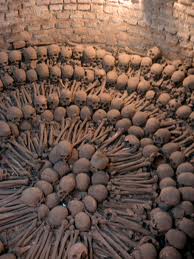
This is one of the most beautiful and monumental Churches in the whole world, with his Baroque front, his tow bell towers and his particular Square is a wonderful construction that is an obligated destination.
Inside of the Church you can blown away by the beauty and well preserved paintings of their principal benefactor, Saint Francis, an Italian who lived around the 1200 ad, he is one of the most famous religious who follow the teaching of Jesus Christ, being very helpful to the most needed and one of the few people who had the stigmas that Jesus has on his hands, some kind of wounds that Jesus got it from his crucifixion.
The church was built in 1545, and it has been modified many times because of the earthquakes that Lima has suffered, but is not losing his beauty inside and out of the Church, inside the temple you can see the richness of the work in wood and also their Library with over 25 thousand books from philosophy, theology and laws.
One thing in particular is that below this Church was buried many people, because Lima doesn’t have a cemetery until the XIX century. It was called the Catacombs, which is a place where almost 20 thousand people were buried in this place, is an overwhelming site where you can see the different kinds of bones that were place in a very artistic way, like one of the group of bones were used to a anti-earthquake, resisting many centuries.
The San Pedro Church and the Jesuit order
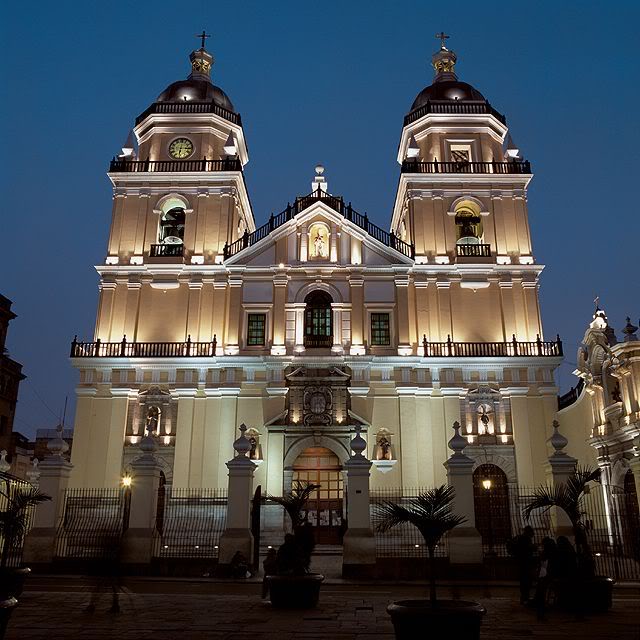
This church is one of the finest and most aristocratic churches on Lima, build in 1638, it has on his front a neoclassic style, with his 2 bell towers and his 3 doors, something unique in the Lima Churches. Inside the Church it has the most rich and beautiful paintings and golden decorated in the entire city, all thanks to the Italian painter artist Bernardo Bitti, a person so influential in the colonial period.
The Jesuits were the most influential of all the orders, because they were in charge of teaching to the natives all concern to education, History and many others subjects. His founder, San Ignacio de Loyola conceived the idea of create an religious army, the Jesus company, on August 15th of 1534, but the Jesuits came to Perú on 1568, almost 40 years after the Company was created.
According with the Jesuit Father and Historian, Rubén Vargas Ugarte, it said that inside their cloisters, keeps many relics related to the Christian History, like: 2 pieces of wood from the cross that where Jesus was crucified, one of the spines from the spines crown that Jesus wore the day he was carrying his cross, a bone of the Apostle Saint Paul, a bone of the head of the Apostle Saint Mathew and Saint jeronimous; a letter written by San Ignacio and a little of his ashes, and the most amazing relics: 41 complete bodies of the Christian martyrs, that were located on the Saint Priscilla, Saint Calixto an many other from Rome.
Unfortunately, the Jesuits were expulsed from the Peruvian territory because of some misunderstanding with the Viceroy, but returning on 1871, being so helpful with the Peruvian army during the war with Chile and the Chilean occupation until 1883.
The Basilica of the Mercedarian order
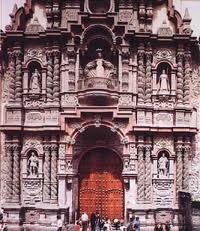
This is one of the greatest and well done Churches of all, build in 1535 by Fray Miguel de orenes, is a truly work of art, his front is made of stone, carved so delicately that it keeps all the details of the characters and is one of the most precious example of the Baroque in the Colonial period.
Inside the church it can see many decorations and excellent work in wood, and also paintings with the most exquisite taste in what colonial symbolism is related. The Baroque style is one of the most intricate of all the styles, with capricious shapes and adorned with many figures like gargoyles and other fantastic creatures.
One thing in particular that caught the attention of all is the cross that is located to the right on the enter of the Church, is a cross with silver and gold decorations, with many inscriptions of a person who made many miracles, is the cross of the Fray Pedro Urraca, a character so amazing because of the develop of his life. When he was coming to Perú, at the age of 19, the ship it was to collapse, and so he exclaimed to the Virgin that if the ship arrives safe he is going to served to God, the ship went safe and the father Urraca starts to served to this order.
One thing in particular was the cross that is on the church, many urban myths and stories tells that the cross belong to the father Urraca, he carries for all over the church at midnight, because he do not want be tempted by the devil, but one night the strong presence of the evil made him run for all over the church, and when he reach to a wall of the church, he, in a miraculous episode, break on trough the wall, and without even a scratch, he went to the other side of the wall, and the same wall is where his church is located. He was buried in the church, as away to remember his great achievement.
The San Agustin Church and the Augustinian order
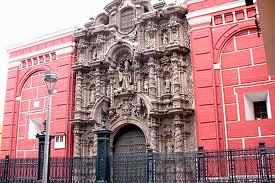 |
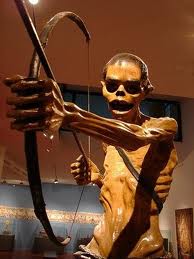 |
Like the rest of the Churches, this is not the exception in what beauty and precise work comes, this is the top of the Baroque style, with images and shapes so intricate that there is no compare with other churches in the country.
Build in 1573 by Fray Luis López de Solís, it been rebuilt many times since the earthquakes that occurred in Lima, like the one in 1746, and in 1895 received many shots during the civil war between democrats and liberals. In 1908 the church was re-opening; remain almost exactly as his original shape.
What is outstanding is his front, the epitome of the Baroque style in architecture, his shapes made in stone, is a very work of art, keeping the resemblance of the La Merced Church, the two are the last remaining churches with this strange but amazing architecture.
Inside the church almost every piece is made in the xx century, but one thing caught our attention, is a wooden sculpture made by the native Baltazar Gavilán called the Death Archer, or just simple the Death, is a very realistic figure of an skeleton in position to throw an arrow. This figure is one of the creepiest and admirable pieces of the Baroque style, that always has a thing for such things like this, however is a truly work of art and remains in the imaginary of the people that visits.
